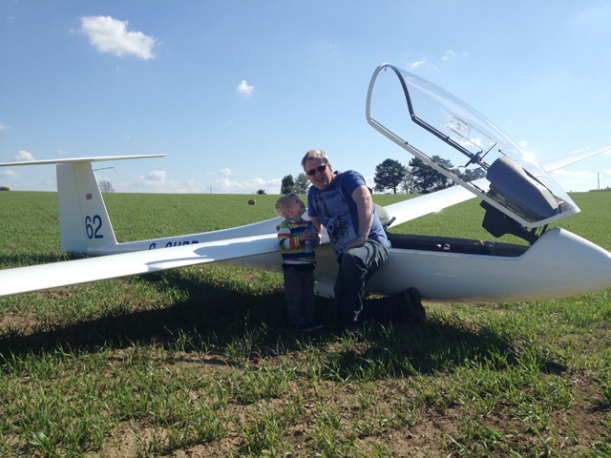It’s funny how my most memorable landouts seem to happen when flying competition tasks. Whether it’s because the tasks are sent into more unfamiliar territory, or that I push myself further, I don’t know. But here’s another one from a couple of years back.
It was one of the more successful (weather-wise) Northern Regionals. I think that year, we flew 6 days out of 9, which given the track record of recent years in the UK, was quite good. Saying that, on this particular day we had been set a short task of only 100Km. The met. man had predicted a short weather window, so a short racing task was in order.
The first leg of the task was quite fast and enjoyable. For once I was ahead of ‘the pack’ as we went around the first turning point. The second leg was also fast initially, but the sky ahead was getting increasingly dark, with a distinct line of cloud ahead. As I got closer, I could see that it was raining under the cloud. However, it looked like a relatively narrow band of cloud, and I had a lot of height. I was still way above cloudbase, so I raised the flaps a notch and increased my speed to dive under it. Luckily, the LS6C flies quite well in rain!
The glider was soon quite wet, and we were inevitably losing height. As we came out from under the rain, I could see the second TP ahead. Pickering lies where the ground starts to slop up towards the moors. The town itself was in sunshine, and I could see a quarry behind the town that was facing into the sun (and the wind), so I thought it would be a likely spot for a thermal. I headed towards it, passing over the TP as I went.
I reached the quarry quite low, and a weak burble on the vario gave me hope. But unfortunately, the weak burble was all I got. I decided to go back over the town, now at around 1000 feet above it. Nothing there either. I decided that the squall line I’d passed under had probably killed the thermals, and it was taking some time to re-cycle. But, looking up, the sky was clear blue, all the way over the moors and to the coast. Oh dear… perhaps that was a sea-breeze front that I had passed under.
I was now down to 700 feet and I had a field picked. It was a very large field next to a main road, and had two gates. There was a tree in the middle of it and people at one end, but the field was so large that there would be plenty of room for me. As I watched, one of my fellow competitors landed in it. And then I hit a thermal.
Seizing my chance, I turned hard into the weak, narrow thermal. Half a knot. Oh well, it might develop into more if I could stick with it.
I must have sat in that thermal for a good 20 minutes, trying to make it work. But I just couldn’t make any headway. I’d gain 50 feet, then lose it. I kept tracking into wind, to try to find the next bubble of the thermal, and occasionally I’d was rewarded with another half-knot burble. But eventually the thermal dissipated, the lift turned to sink and I realised I’d have to land. I was now down to less than 600 feet and in a good position for a circuit for my chosen field. One final check of the field, and then I put the gear down and committed to landing.
The landing itself was uneventful, and the field was truly massive. As I taxied up alongside the Discus that had landed previously, its pilot gave me a cheery wave. I wandered over the speak to him after I’d rung my hubby to come and fetch me.
We’d landed in the field used for the Pickering Showground, two days prior to the show. The group of people were setting out markers and posts at one end of the field, and one of them walked over to us and told us that the main gate to the field was locked and they didn’t have a key. The other gate to the field was open, as some workmen were working on a new roadside pylon and had their machines in the field. However, they were due to leave at 4.30 pm and would be locking the gate behind them. It was already 3.30 pm, so we didn’t have much time!
At that point, a third glider (ASW27) joined us in the field. We gave its pilot the bad news, and he rung his crew to tell them to hurry. If we didn’t get the gliders out by 4.30, it looked like we would have to carry them all out over the fence!
Luckily, the Discus pilot’s crew arrived just then. We planned to get his glider into its trailer, then use that to block the gateway and prevent the workmen from closing the gate, if necessary. My trailer arrived shortly after, and we de-rigged my glider. The ASW27’s pilot’s trailer arrived just as we shut the lid of my trailer, so we de-rigged his glider too. We were all done by 4.25pm, just in time! We all left the field with a huge sigh of relief, as you might imagine.
It just goes to show, even when you think a field looks perfect from the air, there can still be something in it which can spoil your day!


